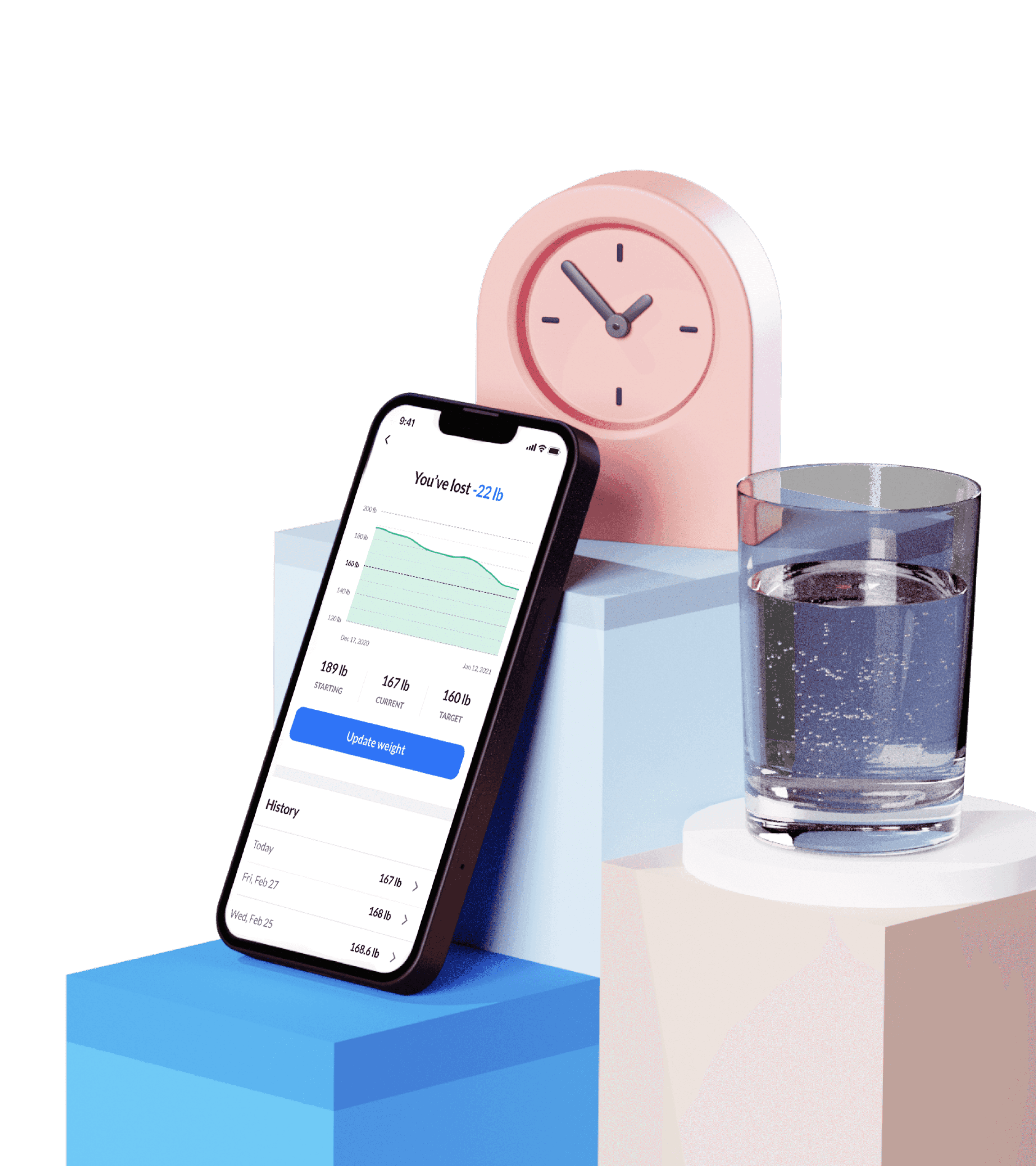Contents
1. Focus on Healthy Foods
The kind of foods that you eat are directly related to your blood sugar. While many people think you just need to reduce your carb intake, it actually depends more on the kind of carbs you’re eating.
Those with prediabetes need to focus more on healthy eating in general. This means eating whole grains over refined and processed grains and eating leaner meats. Below is a summary of some of the kinds of foods you should eat.
- Whole grains, like brown rice, quinoa, barley, and spelt
- Legumes, like peas, chickpeas, kidney beans, and lima beans
- Nuts and seeds
- Poultry and lean meats
- Healthy proteins, like eggs, Greek yogurt, and tofu
- Low-fat dairy products
Take a
1-minute quiz
and discover how much weight you can lose with DoFasting!

2. Keep in Mind the Glycemic Index in Carbs
Glycemic index refers to the rate at which foods raise blood sugar levels once eaten. A higher GI means that the food will be broken down into simple sugars more quickly, leading to a spike in blood sugar. All foods are measured against the rate at which glucose itself raises blood sugar.
Those with prediabetes tend to be recommended low GI foods. This is because they help you to control blood sugar levels better and help you to avoid blood sugar spikes.
Foods with more fiber tend to have lower glycemic loads because fiber helps to slow the breakdown of sugars. It means that when choosing fruit and vegetables to consume, the higher fiber options tend to be better.
In addition, these high levels of fiber mean that low GI foods could keep you fuller for longer. This is helpful if you’re trying to lose weight too. Losing weight is also recommended for those with prediabetes as it can help lower the risk of developing type 2 diabetes.
High GI foods include:
- Sugary drinks
- White bread
- Potatoes
- White rice
Low GI foods include:
- Some fruits and vegetables
- Pulses
- Wholegrains
Some easy-to-remember GI tips
- Foods that contain refined sugars tend to have higher GI levels than foods that contain natural sugars, such as fruit.
- Sweet potatoes, most vegetables, whole fruits, and legumes have lower GI values than white, starchy vegetables, such as potatoes.
- Pasta cooked al dente tends to have lower GI values than pasta cooked longer.
- Parboiled rice, basmati rice, and brown rice all have lower GI values than short-grain or jasmine rice.
3. Opt for Healthy Grains
Whole grains are generally better for your health anyway, but for those with prediabetes, they are a must. Whole grains tend to have much lower glycemic indexes and so won’t affect blood sugar as refined and processed carbs would.
Whole grains are better for your health and are part of a healthy lifestyle. They lower your risk of cardiovascular disease, support healthy digestion, and are even thought to reduce chronic inflammation.
Examples of good whole grains to consume include:
- Barley
- Brown rice
- Buckwheat
- Millet
- Oatmeal
- Bulgur
4. Watch Your Fats
There are different kinds of fat, and some of it is good and some bad. For those with prediabetes, it is best to opt for unsaturated, healthy fats and avoid saturated and trans fats.
The American Diabetes Association recommends choosing monounsaturated and polyunsaturated fats. Unsaturated fats are better for the heart and can protect against cardiovascular disease. They may also help to keep cholesterol levels in check.
Those with prediabetes and type 2 diabetes are at increased risk of certain heart conditions, so protecting against them is a good idea. Good, healthy fats include avocados, olive oil, and fats found in nuts and seeds.
5. Eat Lean Meats
Though meats don’t contribute to your carbohydrate intake, they do affect your fat intake. It means you need to eat meats with fewer saturated fats. Lean meat is the best option. Examples include:
- Skinless chicken
- Lean, grass-fed beef
- Fish, like tuna, cod, and flounder
- Shellfish, like crab and lobster
- Skinless turkey
6. Control Your Portion Sizes
Portion control can help to keep you on track with a low GI diet. Learning how nutritional information labels work and making sure that you eat the recommended amount can help keep your blood sugar levels within a healthy range.
You could also try mindful eating, where you stop eating when you’re full and only eat when you’re hungry.
7. Fill Up on Fiber
Fiber is great for your blood sugar. It slows the breakdown of food and ensures you don’t crash after eating. It also helps to keep you fuller for longer and can support a healthy digestive system.
High fiber foods include:
- Beans and legumes
- Fruits and vegetables
- Wholegrains
If you’re concerned you’re not getting enough fiber, you could also supplement your intake with a fiber supplement, like the DoFasting Fiber Complex. It helps support a healthy digestive system and improves skin and hair health.
Take a
1-minute quiz
and discover how much weight you can lose with DoFasting!

8. Drink Alcohol Only in Moderation
Many alcoholic drinks are incredibly sugary drinks that will affect blood glucose levels. They’re also dehydrating and can lead to health problems later in life. Alcohol should be consumed in moderation by everyone, but it is particularly important for those with prediabetes.
If you are planning on drinking, ensure that you don’t mix your beverage with sugary mixers, and remember that some drinks have more carbohydrates than others. You should remember portion control and your carbohydrate intake when consuming alcohol.
9. Avoid These Foods Completely
For those with prediabetes, there are some foods that you should always avoid. These foods tend to have high levels of refined sugar and can cause a massive spike in blood glucose levels.
They also come with other risk factors, including affecting your overall health, and should not be a part of a healthy diet.
Foods to avoid include:
- Refined grains, like white bread and pasta
- Sugary beverages, like soda and cocktails
- Fried foods, like takeaway food
- Processed meats
- Sweets
10. Make Sure You Drink Enough Water
Drinking enough water is part of a healthy diet and should be one of the many lifestyle changes you make upon a diagnosis of prediabetes. The amount of water you drink depends on the amount of physical activity you do, but a good rule of thumb is about 2.7 liters for women and 3.7 liters for men.
11. Get Some Exercise
Getting enough exercise each week can help reduce the risk of developing several health conditions and help you maintain a healthy weight. For those with prediabetes, a lack of exercise can actually lead to increased insulin resistance, so it is important to add to your routine.
It is recommended that you get at least 150 minutes of moderate exercise each week to maintain good health.
12. Take Your Meal Times Into Account
When you eat can also affect your condition. It is best to make lunch your biggest meal and to ensure you eat a smaller meal at dinner. You should also ensure you stop eating at least three hours before bedtime. Eating late at night is linked to elevated blood sugar levels.
It is also crucial that you do not skip meals. Skipping meals leads to increased hunger which can, in turn, lead to overeating. Overeating puts you at risk of weight gain and could lead to obesity. Those who are overweight are at higher risk of developing type 2 diabetes.
Can Intermittent Fasting Help Prevent Prediabetes?
Intermittent fasting is a dieting method that involves eating and fasting periods. There are many different types of intermittent fasting, including the 12-hour fast, the 16:8 method, and the Warrior Diet. Many people successfully lost weight using this dieting method, but it may have other benefits too.
Intermittent fasting can help you to lose weight. This is because it puts you at a natural calorie deficit by restricting the time you’re allowed to eat. In addition, long fasting periods can induce a state of ketosis, which helps with fat reduction too.
Losing weight is thought to help those with type 2 diabetes and prediabetes, which means intermittent fasting could have some benefits for prediabetes.
The dieting method may also have some effect on blood glucose levels and insulin sensitivity. There is some evidence that fasting can help to improve insulin resistance. Improving insulin resistance can benefit those with prediabetes and may reduce their risk of developing type 2 diabetes.
Additionally, intermittent fasting could have a positive effect on blood sugar levels, which could be useful for those with prediabetes.
Though more research is needed, there is some evidence that intermittent fasting could be an effective method of managing prediabetes.
Along with its ability to help prediabetes, intermittent fasting can also promote heart health, improve brain health, focus, and clarity, and possibly improve disease control. Even with these benefits, there are some people who should not try fasting, including those with kidney problems, those who are pregnant and breastfeeding, and anyone with a history of disordered eating.
If you have been diagnosed with prediabetes or type 2 diabetes, you must speak with a doctor before you start to ensure you understand any risks.
If you’re considering trying intermittent fasting, why not check out the DoFasting app. The app can help you understand your chosen fasting style and provides a space for you to track your caloric intake. It comes with a fasting reminder to tell you when to stop eating and even offers workouts suitable for this kind of diet.
You can also get in touch with the community to answer any questions about your fasting style and stay motivated together as you follow an intermittent fasting dieting plan.
Take a
1-minute quiz
and discover how much weight you can lose with DoFasting!

Conclusion
If you have been diagnosed with prediabetes, you are likely to have been given a specific diet to follow. For those with the condition, it is best to stick to healthy and whole foods, including whole grains, fruits, and vegetables.
You should also watch your carbohydrate and fat intake, sticking to whole, unrefined carbs and unsaturated, healthy fats. You should also increase your activity levels and drink enough water each day.
Prediabetes is a manageable condition and changing your lifestyle could help you to limit the symptoms of the condition.
See how DoFasting will improve your life
Find out what works for you with this 60-sec quiz approved by our experts and get your personal revolutionary fasting assistant.
Start the Quiz














